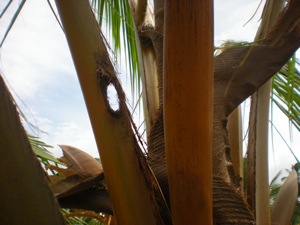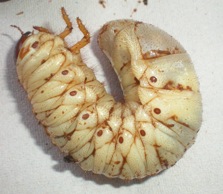Crop Protection :: Pest of Coconut
Rhinoceros beetle: Oryctes rhinoceros
Pest population occurs round the year but population maximum during June – Sep coinciding with the onset of monsoon.
Symptoms of Damage:
 |
 |
 |
Holes in central spindle
|
Holes with chewed fibre sticking out in central spindle |
Triangular cuts on leaves |
- The adult beetle bores into the unopened fronds and spathes. Damage by the pest leads to 10 to 15% loss in yield.
- The attacked frond when fully opened shows characteristic triangular cuts.
- Central spindle appears cut or toppled
- Fully opened fronds showing characteristic diamond shaped cuttings
- Holes with chewed fibre sticking out at the base of central spindle.
Identification of the Pest:
 |
 |
Grub
|
Rhinoceros Beetle |
- Egg: Oval creamy white egg in manure pits or decaying vegetable matter at a depth of 5 to 15 cm. Egg periods is 8 to 18 days. Female laid 140 to 150 eggs.
- Grub: Grub is stout, sluggish, white "C"-shaped with pale brown head and found at a depth of 5 to 30 cm.
- Pupa: Grub pupates in earthen cells at a depth of 0.3 to 1 m
- Adult: Adult beetle is stout, brownish black or black and has a long horn projecting dorsally from the head in male. Horn is short in female.
Management:
(i) Cultural Method:
- Remove and burn all dead coconut trees in the garden (which are likely to serve as breeding ground) to maintain good sanitation.
- Collect and destroy the various bio-stages of the beetle from the manure pits (breeding ground of the pest) whenever manure is lifted from the pits.
(ii) Mechanical Method:
- During peak period of population build up, the adult beetle may be extracted from the palm crown using GI hooks.
- Set up light traps following the first rains in summer and monsoon period to attract and kill the adult beetles.
(iii) Chemical Method:
- The topmost three leaf axils around the spindle may be filled with any of the following mixtures as a prophylactic measure:
(a) Sevidol 8G 25 g + fine sand 200 g, which is to be done thrice in a year in April-May, September-October and December-January.
(b) For seedlings, apply Naphthalene balls 10.5 g (approx. three to four balls) covered with fine sand, once in 45 days.
- Place phorate 10 G 5 g in perforated sachets in two inner most leaf axils for 2 times at 6 months intervals.
- Treat manure pits and other possible breeding sites with 0.01% carbaryl (50 % WP) on w/w basis. Treatment will have to be repeated every six months.
(iv) Trap Method:
 |
 |
Rhinoceros Beetle
|
Trapped Rhinoceros Beetle |
- Set up Rhino lure pheromone trap @ 5 traps/ha to trap and kill the beetles. The dispenser may be hanged in a plastic bucket having 2 liter of insecticide solution once in a week. Trapped beetles can be disposed off.
(v) Biological Method:
- Application of green muscardine fungus, Metarrhizium anisopliae @ 5 x 1011 spores / m3 - spray 250ml Metarrizhium culture + 750ml water in manure pits to check the perpetuation of the pest.
- Field release of Baculovirus oryctes inoculated adult rhinoceros beetle @ 15 beetles/ha reduces the leaf and crown damage caused by this beetle.
- Soak castor cake at 1 kg in 5 liter of water in small mud pots and keep them in the coconut gardens to attract and kill the adults.
- Apply mixture of either neem seed powder + sand (1:2) @150 g per palm or neem seed kernel powder + sand (1:2) @150 g per palm in the base of the 3 inner most leaves in the crown.
|
|







